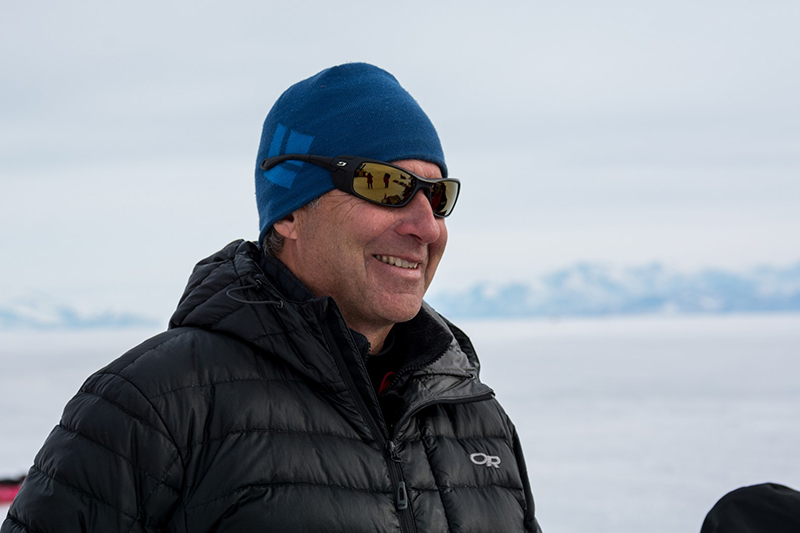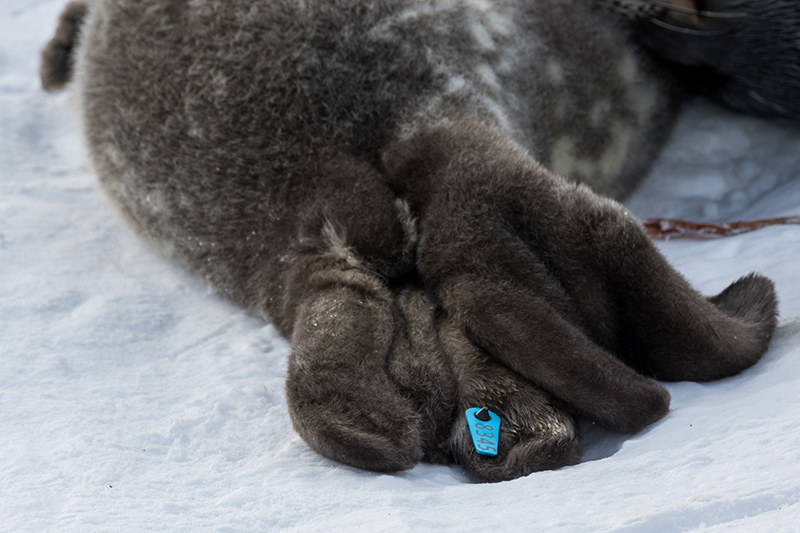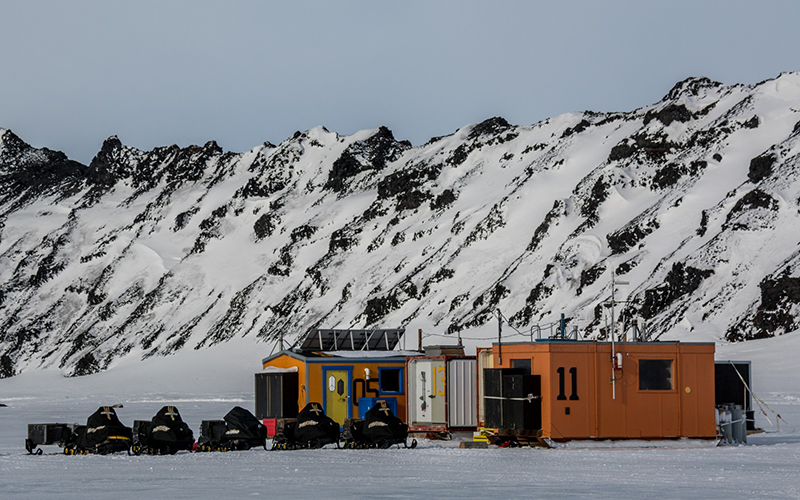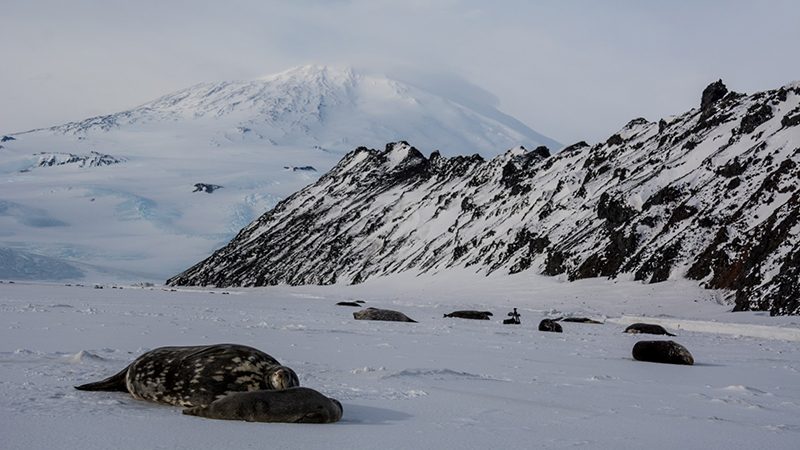50 Years of Weddell SealsWhat scientists are still learning after studying the world’s southernmost mammal for half a centuryPosted December 21, 2018
For a half a century, generations of researchers have studied various aspects of the life cycle of generations of Weddell seals around Antarctica's McMurdo Sound, making them some of the most closely studied mammals on the planet. The continuous research has gone on so long that, over the years, records that are now kept digitally once were jotted down on handwritten index cards. Reclining seals are a ubiquitous sight on the sea ice around Ross Island. Every season hundreds of pregnant mothers converge around the region to give birth on the ice and care for their young. They often return to the same areas every year, and researchers have been tracking these colonies continuously since 1968. More than 50 years of collected data and with almost 25,000 tagged animals, scientists have learned a wealth of knowledge about how they live, breed, and survive in the harsh environment around Antarctica. "For long-lived animals such as these, it takes a long-term study to understand their lives," said Jay Rotella, who with Bob Garrott, both of Montana State University, have been the principal investigators on the project since 2002. Their research is supported by the National Science Foundation, which manages the U.S. Antarctic Program. Over the decades seal research has passed among a number of different principal investigators, focusing on many different aspects of the seals' population dynamics. Other research teams in the region also conduct studies of seal physiology, movement patterns and genetics and rely on the data that the census has compiled. "We keep advancing the questions," Rotella said. 
Photo Credit: Mike Lucibella
Jay Rotella of Montana State University has been principal investigator on the project since 2002.
However, a census of seals born in the region has remained central to the project since the tagging began. Every season, Rotella and his team set up camp a few miles from NSF's McMurdo Station and count every seal pup born in the area. They record where it was born, when it was born and which animal was the mother. As the season progresses past the pupping season, they survey the adults to see who’s returned and to where. Just as the questions have advanced, the technology used to track the animals has as well. "One of the big changes were the field computers and the electronic database," Rotella said. Before the computers in the mid-1980s, data were recorded on index cards. Now, the team is able to maintain their database with the use of handheld computers out in the field. 
Photo Credit: Mike Lucibella
Every year the research team tags hundreds of seal pups to track how many are born and to what mother. NMFS Permit 21158.
More recently under Rotella and Garrott, the research has focused on trying to better understand the relationship between an animal’s body mass and its ability to survive and reproduce successfully. "We've been learning how much mothers weigh, when they gave birth, and how much they lose and how much the pups gain," Rotella said. "The current project is about what does a mother do for her baby and how does that affect the baby's prospects for surviving and producing offspring." After a seal pup is born, it's nursed by its mother for a little more than a month, then weans and leaves the colony on its own, entering the most dangerous time in its life. Researchers think that only about twenty percent of female pups will return and have a pup of their own. Rotella and his team are looking at seals that do return and are trying to find a correlation between the mother's characteristics and the likelihood that her pup will survive. "What we've focused on more recently is maternal effects, differences in individuals," said Kaitlin Macdonald, a graduate student at Montana State University. "What we've been looking at is what makes a mom a good mom or a bad mom." After giving birth, seal mothers convert a large portion of their own body reserves to produce milk for their pup. The pups grow significantly in the first month of their life while nursing, but as they do so their mothers lose body mass. In part the researchers are studying whether seal pups whose mothers were larger do better, how much mass the mothers are likely to lose and what that does to the mother when she returns the following year. "Bigger moms lose a bigger proportion of mass, smaller moms lose smaller proportions of their mass," Kaitlin said. "You want your mom to be big." 
Photo Credit: Mike Lucibella
The researcher's main camp is set up on the sea ice in the lee of Big Razorback at the foot of Mount Erebus.
The relationship between a mother's energetic investment and offspring survivability is a fundamental question in biology, and the close study of these seals offers insights beyond just these inhabitants of the Southern Ocean. "It applies even more broadly to other large, long lived mammals," said Kaitlin. The dataset has proved a valuable tool for researchers studying a number of different animals around the world. In ecology, it's rare to have such detailed and extensive data about a region’s entire population, records that track the lineage of nearly every creature born in a region. In addition, though these seals are relatively easily for researchers to access from NSF's McMurdo Station, they live in a nearly pristine region, free of human disturbances. That's key to understanding how this population responds to natural, normal changes in the environment and offers insights into how other animals are responding to changes caused by humans. "This is a population that is working well so it's really important to understand how it works," said Bill Link, a research statistician with the U.S. Geological Survey. "It's a really healthy population that’s not in decline." Being able to study them so closely is possible in part because of the docile nature of Weddell seals. Having evolved on a continent with no natural predators above the ice, the seals are unbothered by the researchers tagging them and weighing the pups. "Each seal has different a personality, but they are often docile," said Victor Villalobos, a research technician with the study who has previously worked on grizzly bear population studies. "I've never been able to get between a mom and her young… It's so different from North America and being able to approach [seals] up close." 
Photo Credit: Mike Lucibella
The team live and work out of the camp for about six weeks each season.
Though the researchers closely study the regional population of seals during the beginning of the austral summer, in many ways they're scratching the surface. "We're only here for about two and a half months," said Shane Petch, a graduate student at Montana State University. "We just get this snapshot of how the population is doing during the Antarctic spring and summer, and we're trying to take that snapshot and learn as much as we can about the broader population." In the earliest days of the project, little was known about Weddell seals in the region. At the time, researchers were looking to understand some of the most basic questions about the animals, including how many there are in the region, how long they live and how old they tended to be before they start breeding. Though project and dataset has evolved and grown since then, many of the techniques that are still used today were established early on. In 1968, the first iteration of the project used a radio receiver installed at the colony at Hutton Cliffs to record every time any radio-tagged seals emerged from the water. It gave the researchers their first comprehensive look at how long and how often seals spent above the ice. Then in 1973, the project started to evolve to resemble what it is today. Researchers began keeping track of all of the seals born in the area, tracking the population of seals from year to year using livestock tags attached to their flippers. "By the late 1970s, things had pretty much taken shape and the fundamental field methods have pretty much stayed the same," Rotella said. NSF-funded research in this story: Jay Rotella, Montana State University, Award No. 1640481. NMFS Permit 21158. |



For USAP Participants |
For The Public |
For Researchers and EducatorsContact UsU.S. National Science FoundationOffice of Polar Programs Geosciences Directorate 2415 Eisenhower Avenue, Suite W7100 Alexandria, VA 22314 Sign up for the NSF Office of Polar Programs newsletter and events. Feedback Form |




